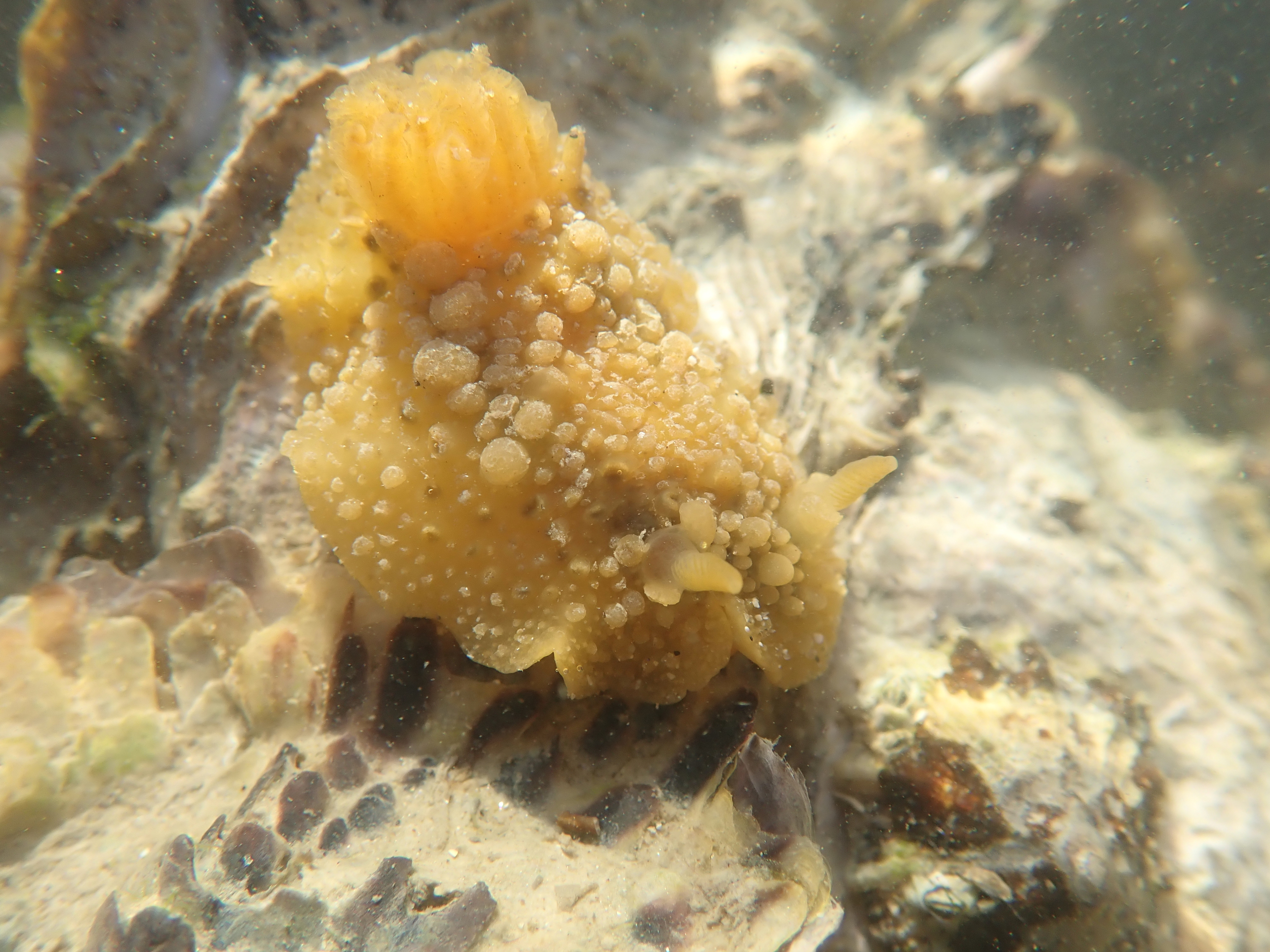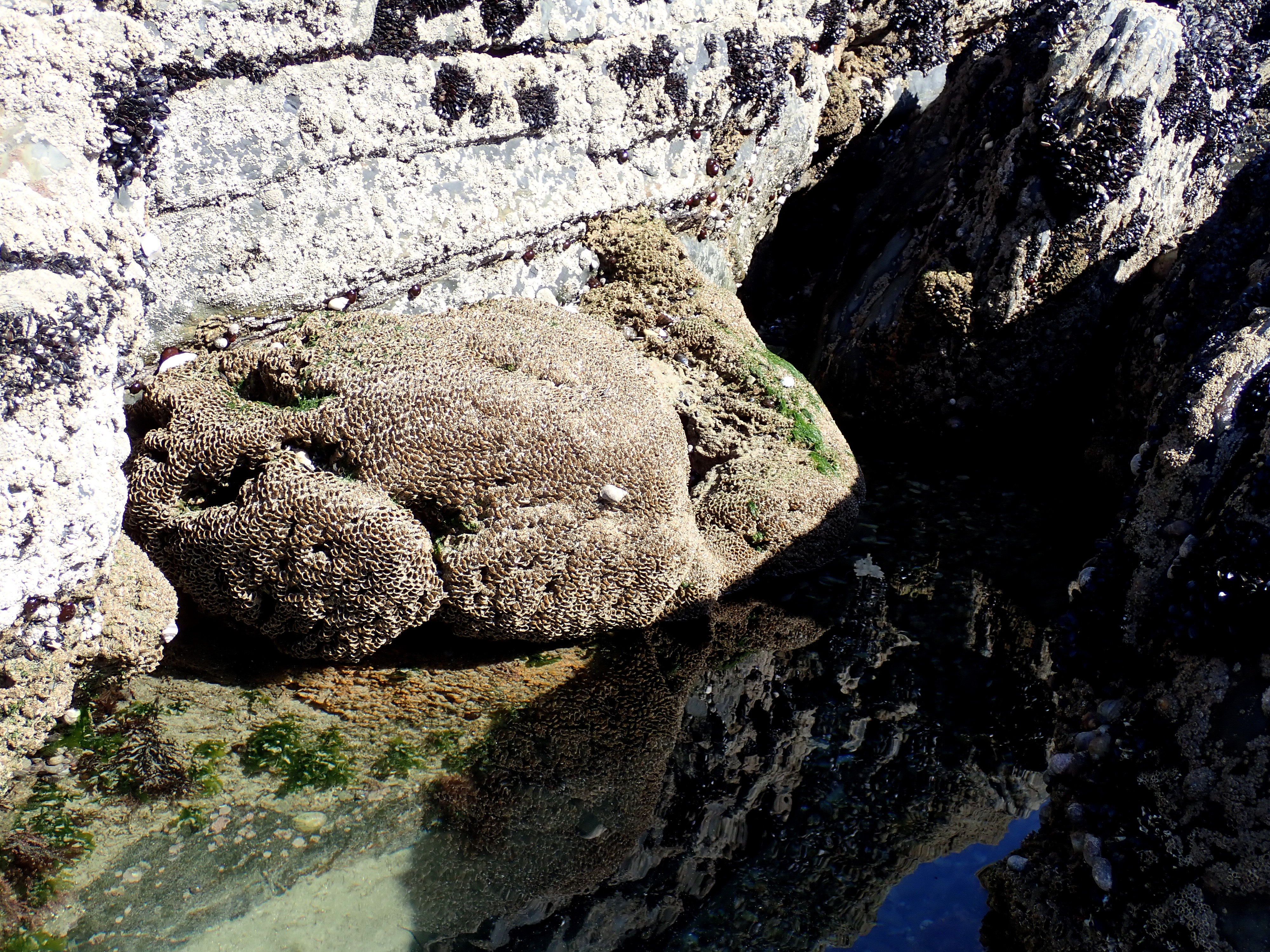We tread extra-carefully around the pool, even though we’ve already guessed the St Piran’s hermit crabs won’t be here. The trail of destruction left by the powerful easterly gales is evident: boulders have been lifted by the waves and tossed far from their usual positions, the rich coatings of sponges, squirts and hydroids on their undersides gone. Life is still going on but not as before.
Junior finds a rock goby and some pipefish, but the pool feels like a shadow of its former self. The signs are not good for the nursery of young St Piran’s hermit crabs* (Clibanarius erythropus) that we have been monitoring for the last year.
One thing we have learned from watching these starry eyed, red-whiskered, bristly-legged hermit crabs is that they tend to huddle together. Unlike our common ‘Bernard’ hermits, we usually find the St Piran’s crabs congregated in just two pools on the beach. In this particular pool, there is a central rocky island where all the tiny young crabs like to hang out under a sponge-coated rock, scuttling around like a bunch of kids at the soft play, while the adults are normally found quietly feeding in an adjacent pool.

We haven’t seen a single St Piran’s hermit crab in the adult pool. They are easily distinguished from the common hermit by their equal-sized claws and bright red antennae, which are visible at a quick glance, even if most of the crab is well-hidden in the shell.

As we approach the nursery area I almost don’t want to look. I see a common periwinkle shell sprout legs and my heart jumps. I kneel on a rock to look closely, but it is a common hermit crab, using its oversized right pincer to explore the coral weed, searching for food.

Among the nursery rocks, there is nothing.
Last time we were here, before the storms hit, every little shell had a St Piran’s hermit crab inside. Now, apart from a broad clawed porcelain crab clinging to the underside of a stone, the area is eerily quiet.
Cornwall’s shores are no strangers to fierce weather and, in places, there are signs of a recovery already, with new seaweed growth and newly-forming sea squirts. St Piran’s hermit crabs, on the other hand, are already at the northern limit of their range here, so they may not cope well with cold winter gales and dips in the sea temperature.
At the far end of the pool I find a chiton on the rock and stop to take a photo. These animals are molluscs but look more like woodlice than snails with their plate-armour shells. Unlike their crustacean look-alikes they have no legs and live firmly attached to the rock.

A flat periwinkle shell on the sand behind the chiton catches my eye. It’s not an unusual shell, but the living shells are usually found feeding on the seaweed and most of the loose shells have been swept away by the storm. There are other small shells close by and they are likely to all be hermit crabs.
My instincts are good. Just as I turn the flat periwinkle shell and glimpse the red antennae deep inside, Junior crouches next to me and shouts that he thinks he can see a St Piran’s crab.

We soon discover that every little shell in this part of the pool is a St Piran’s. Our nursery crabs are still here and have upgraded to bigger shells. There are dozens of them.


It is still early days for this hermit crab that returned to Cornwall’s shores relatively recently after a long absence. In the past it was only an intermittent resident but warming seas may enable these hermit crabs to breed successfully here. On the other hand, an increase in storm events or a weakening of the Gulf Stream could have the opposite effect. A changing climate risks heavier rain bringing more pollution from our rivers and changes in marine oxygen levels and in the plankton on which the food chain depends.
The marine ecosystem is sensitive to our changing climate and so complex that it is extremely hard to predict the exact impacts of changes. (If you’re interested to find out more, check out the Marine Climate Change Impacts Partnership 2020 Report Card).
Further down the shore we find slightly less storm damage and some of the rock pool residents in their usual places. A young topknot flatfish demonstrates its ability to sucker onto the rocks and glide across the seabed, moulding its body to every contour.

In what feels like a reward for our persistence, we find a fabulous Geitodoris planata slug on the lower shore. This time of year, lots of slugs are beginning to spawn.

We find a second G. planata in another pool. I am tempted to do some matchmaking, but we leave the slugs where we found them and let nature take its course.


The sun is shining, the St Piran’s crabs are still here, we have seen our favourite nudibranch slug and we have every reason to think that the shore will recover well from the impact of the storms as the spring arrives.
All that is left to do is to head home to prepare our pasties and saffron buns for St Piran’s Day. I would share photos of them, but they were gone too fast!
Gool Peran Lowen!
* I understand that some our lovely neighbours in Devon aren’t so keen on the use of the common name ‘St Piran’s’ for the Clibanarius erythropus hermit crab, which has returned to parts of West Devon as well as to Cornwall. I am completely biased, but the name seems a good fit and it saves me from attempting to pronounce the scientific name. The legend of St Piran says that he was thrown into the sea in his native Ireland with a millstone tied to him, but floated across the sea to Cornwall. The hermit crabs also arrived floating in the plankton from somewhere, most likely Brittany, which also has connections with St Piran. The hermit crab’s striking black and white eyes match the colours of the Cornish flag. I’ve heard plenty of other common names for this crab and anyone can invent their own. In other parts of Europe Clibanarius erythropus has names meaning ‘Little Hermit Crab’, ‘Devil’s Hand Crab’ and ‘Antisocial Crab’, among others.




































































